North Germanic peoples
| Regions with significant populations | |
|---|---|
| Languages | |
| North Germanic languages | |
| Religion | |
| |
| Related ethnic groups | |
| Other Germanic peoples |
| Part of a series on |
| Indo-European topics |
|---|
 |
|
|
Origins |
|
Archaeology Pontic Steppe Caucasus East Asia Eastern Europe Northern Europe Pontic Steppe Northern/Eastern Steppe Europe
South Asia Steppe Europe Caucasus India |
|
Peoples and societies Indo-Aryans Iranians Europe East Asia Europe Indo-Aryan Iranian |
|
|
| Norse people |
|---|
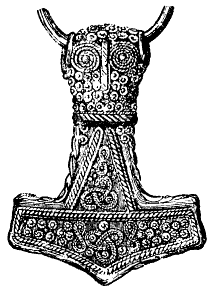 |
|
Categories
|
North Germanic peoples, sometimes called Scandinavians,[1] Nordic peoples[2] and in a medieval context Norsemen,[1] are a Germanic ethnolinguistic group of the Nordic countries.[3] They are identified by their cultural similarities, common ancestry and common use of the Proto-Norse language from around 200 AD, a language that around 800 AD became the Old Norse language, which in turn later became the North Germanic languages of today.
The North Germanic peoples are thought to have emerged as a distinct people in Sweden in the early centuries AD.[4] Several North Germanic tribes are mentioned by classical writers in antiquity, in particular the Swedes, Danes, Geats and Gutes. During the subsequent Viking Age, seafaring North Germanic adventurers, commonly referred to as Vikings, raided and settled territories throughout Europe and beyond, founding several important political entities and exploring the North Atlantic as far as North America. Ethnic groups that arose from this expansion include the Normans, the Norse-Gaels and the Rus' people. The North Germanic peoples of the Viking Age went by various names among the cultures they encountered, but are generally referred to as Norsemen.[5]
With the end of the Viking Age in the 11th century, the North Germanic peoples were converted from their native religion to Christianity, while their previously tribal societies were centralized into the modern kingdoms of Denmark, Norway and Sweden.[6][5][7] Modern North Germanic ethnic groups are the Danes, Faroese people, Icelanders, Norwegians and Swedes.[8][9] These ethnic groups are often referred to as Scandinavians, although Icelanders and the Faroese are sometimes excluded from that definition.[10][3]
Names
The modern North Germanic languages have a common word: the word nordbo, (Sw.: nordborna, Da.: nordboerne, No.: nordboerne or nordbuane in the definite plural) which is used for both ancient and modern North Germanic peoples. In English "Norsemen" is the usual term for the speakers of Old Norse, a North Germanic language that was spoken by inhabitants of Scandinavia and inhabitants of their overseas settlements from about the 9th to the 13th century. In the earlier period, and especially when outside Scandinavia, they are also often called Vikings.
Although the early North Germanic peoples definitely had a common identity, it is uncertain if they had a common ethnonym.[11] Their identity was rather expressed through the geographical and linguistic terms The North Lands (Old Norse: Norðrlönd) and The Danish Tongue (Old Norse: Dönsk Tunga).[11]
In the Old Norse language, the term norrœnir menn (northern men), was used correspondingly to the modern English name Norsemen, referring to North Germanic peoples.
In the early Medieval period, as today, "Vikings" was a common term for attacking Norsemen, especially in connection with raids and monastic plundering by Norsemen in the British Isles. The word Vikings: Vikinger in Danish and Norwegian Bokmål, and Vikingar in Swedish and Norwegian Nynorsk is not used as a word for Norsemen by natives, as "Viking" is the name for a specific occupation or activity (a "raid"), and not a demographic group. The Vikings were simply people (of any ethnicity, or origin) partaking in the raid (known as "going viking").[12]
The Norse were also known as Ascomanni (Ashmen) by the Germans,[13] and Dene (Danes) by the Anglo-Saxons.[14] The Old Frankish word Nortmann "Northman" was Latinised as Normanni and then entered Old French as Normands, whence the name of the Normans and of Normandy, which was conquered from the Franks by Vikings in the 10th century.[15][16]
The Gaelic terms Finn-Gall (Norwegian Viking or Norwegian), Dubh-Gall (Danish Viking or Danish) and Gall Goidel (foreign Gaelic) were used for the people of Norse descent in Ireland and Scotland, who assimilated into the Gaelic culture.[17] Dubliners called them Ostmen, or East-people, and the name Oxmanstown (an area in central Dublin; the name is still current) comes from one of their settlements; they were also known as Lochlannaigh, or Lake-people.[14]
The Slavs, Finns, Muslims, Byzantines and other peoples of the east knew them as the Rus' or Rhōs, probably derived from various uses of rōþs-, i.e. "related to rowing", or from the area of Roslagen in east-central Sweden, where most of the Vikings who visited the Slavic lands originated. After the Rus' established Kievan Rus' and gradually merged with the Slavic population, the North Germanic people in the east become known as Varangians (ON: Væringjar, meaning "sworn men"), after the bodyguards of the Byzantine known as the Varangian Guard.[18]
History
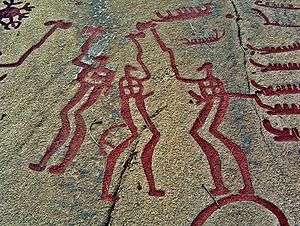
Prehistory
The Battle Axe culture emerged in the southern Scandinavia in the early 3rd millennium BC. The Proto-Germanic language is thought to have emerged from this culture, possibly through is superimposition upon the earlier megalithic cultures of the area.[19] The Germanic tribal societies of Scandinavia were thereafter surprisingly stable for thousands of years.[20]
Scandinavia is considered the only area in Europe where the Bronze Age was significantly delayed for a whole region.[21] The period was nevertheless characterized by the independent development of new technologies, with the peoples of southern Scandinavia developing a culture with its own characteristics, indicating the emergence of a common cultural heritage.[21] When bronze was finally introduced, its importance was rapidly established, leading to the emergence of the Nordic Bronze Age.[21]
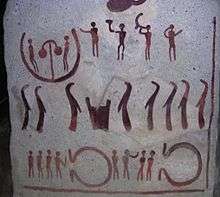
Ancient history
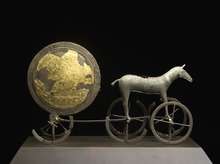
During the Iron Age the peoples of Scandinavia were engaged in the export of slaves and amber to the Roman Empire, receiving prestige goods in return. This is attested by artifacts of gold and silver that have been found at rich burials from the period. North Germanic tribes, chiefly Swedes, were probably engaged as middlemen in the slave trade along the Baltic coast between Balts and Slavs and the Roman Empire. The North Germanic tribes at the time were skilled metal and leather workers, which supplemented their trade in iron and amber.[20][22] In his book Germania, the Roman historian Tacitus mentions the Swedes (Suiones) as being governed by powerful rulers and excelling at seafaring.[22]
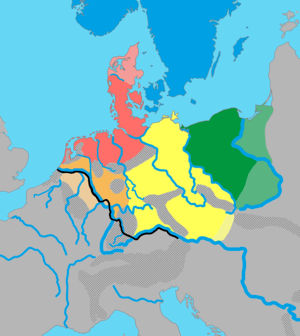
During the Iron Age various Germanic tribes migrated from Scandinavia to East-Central Europe. This included the Rugii, Goths, Gepids, Vandals, Burgundians and others.[19][23][24] The Rugii might have originated in Western Norway (Rogaland).[25] The migrations of most of these tribes is thought to have occurred around 200 BC, though the Vandals might have migrated earlier.[24] According to the historian Procopius, these tribes were distinguished by their height, fair complexion, physical attractiveness and common cultural characteristics, suggesting a common origin.[26] Because of the large number of Germanic tribes that traced their origin to Scandinavia, the region became known by Early Medieval historians as the Factory of Nations (Latin: Officina Gentium) or Womb of Nations (Latin: Vagina Nationum).[24][27] The early Germanic tribes that migrated from Scandinavia became speakers of East Germanic dialects. Though these tribes were probably indistinguishable from later North Germanic tribes at the time of their migration, the culture and language of North and East Germanic tribes would thereafter take divergent lines of development.[28] Another Germanic tribe which claimed Scandinavian origins were the Lombards.[29]
The region of the north, in proportion as it is removed from the heat of the sun and is chilled with snow and frost, is so much the more healthful to the bodies of men and fitted for the propagation of nations, just as, on the other hand, every southern region, the nearer it is to the heat of the sun, the more it abounds in diseases and is less fitted for the bringing up of the human race.[30]
It is likely that Proto-Norse emerged as a separate Germanic dialect around the 1st century.[31] The ethnogenesis of the North Germanic peoples is thought to have occurred in Sweden.[4] Sweden was the home of the earliest attestations of North Germanic culture, and the later North Germanic tribes of Norway and Denmark originated in Sweden.[4] Archaeological evidence suggests that the North Germanic tribes at the time constituted one of five main tribal groups among the Germanic peoples, the others being North Sea Germanic tribes (Frisians, Saxons and Angles), Weser-Rhine Germanic tribes (Hessians, Franks), Elbe Germanic tribes (Lombards, Alemanni, Bavarians) and Oder-Vistula Germanic tribes (Goths, Vandals, Burgundians).[32]
The southward expansion of the East Germanic tribes pushed many other Germanic and Iranian peoples towards the Roman Empire, spawning the Marcomannic Wars in the 2nd century AD.[19] Another East Germanic tribe were the Herules, who according to 6th century historian Jordanes were driven from modern-day Denmark by the Danes, who were an offshoot of the Swedes.[33] The migration of the Herules is thought to have occurred around 250 AD.[34] The Danes would eventually settle all of Denmark, with many its former inhabitants, including the Jutes and Angles, settling Britain, becoming known as the Anglo-Saxons. The Old English story Beowulf is a testimony to this connection.[35] Meanwhile, Norway was inhabited by a large number of North Germanic tribes and divided into a score of petty kingdoms.

Among the early North Germanic peoples, kinship ties played an important role in social organization. Society was divided into three classes, chieftains, freedmen and slaves (thralls). Freedmen were those who owned and farmed the land. Religious leaders, merchants, craftsmen and armed retainers of chieftains (housecarls) were not confined to any specific class. Women had considerable independence compared to other parts of Europe. Important decisions were made by the freedmen at a popular assembly known as the Thing.[20] Their legal system was closely related to those of other Germanic peoples.[36] Dwellings were built according to methods that had changed little since the neolithic. A chieftain typically had his seat of power in a mead hall, where lavish feasts for his followers were held. Merchants frequently operated through joint financial ventures, and legal disputes were often solved through single combat. Men of prominence were generally buried along with their most prized possessions, including horses, chariots, ships, slaves and weapons, which were supposed to follow them into the afterlife.[37]
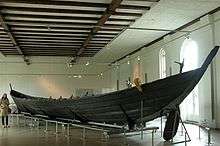
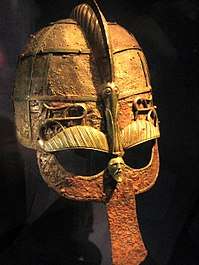
Though the economy was primarily based on farming and trade, the North Germanic tribes practiced a warrior culture similar to related Germanic peoples and the ancient Celts.[20] Warfare was generally carried out through small war bands, whose cohesiveness generally relied upon the loyalty between warriors and their chiefs. Loyalty was considered a virtue of utmost importance in early North Germanic society.[18] An elite group of ferocious North Germanic warriors were the berserkers. A common battle tactic was svinfylking. The North Germanic tribes of these period also excelled at shipbuilding and maritime warfare.[37]
The North Germanic tribes practiced Norse paganism, a branch of Germanic paganism, which ultimately stems from Proto-Indo-European religion.[38] Religion was typically practiced at outdoor temples, where sacrifices were held. The most famous of these was the Temple at Uppsala. Their art was intimately intertwined with their religion. Their stories and myths were typically inscribed on runestones or transmitted orally by skalds.[37] According to North Germanic belief, those who died in battle were gained admittance to Valhalla, a majestic hall presided over by Odin, ruler of Asgard according to their cosmology and the chief god in the North Germanic pantheon. The thunder god Thor was popular with the North Germanic common people.[39]
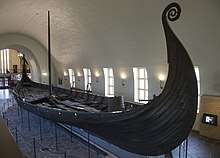
By the 3rd century there seems to have been a disruption of trade, possibly due to attacks from tribes in periphery. In the 4th and 5th centuries, larger settlements were established in southern Scandinavia, indicating a centralization of power. Numerous strongholds were also being built, indicating a need to defend against attacks. Deposits of weapons in bogs from this period suggest the presence of a warrior aristocracy.[20] The Gutes of Gotland are in later Old Norse literature considered indistinguishable from the Goths, who in the 3rd and 4th centuries wrested control of the Pontic Steppe from the Iranian nomads. The Goths were the only non-nomadic people to ever acquire a dominant position on the Eurasian steppe, and their influence on the early Slavs must have been considerable.[40] When the Huns invaded these territories, the North Germanic legends recall that the Gizur of the Geats came to the aid of the Goths in an epic conflict. Rich Eastern Roman finds made in Gotland and southern Sweden from this period are a testimony to this connection.[20]
Archaeological evidence suggest that a warrior elite continued to dominate North Germanic society into the Early Middle Ages.[20] The royal dynasty of the Swedes, the Yngling, was founded in the 5th century. Based at Gamla Uppsala, the Ynglings would come to dominate much of Scandinavia.[20] The importance of this dynasty for the North Germanic peoples is attested by the fact that the later Icelandic historian Snorri Sturluson begins his history of the Norse peoples, the Heimskringla, with the legends of ancient Sweden.[4]
Early Middle Ages
Around 510, the Herules returned to their home in southern Sweden following centuries of migrations throughout Europe, after their kingdom had been overwhelmed by the Lombards.[33] Their name has been connected to the word erilaz attested in Elder Futhark inscriptions and the title Earl.
In his book Getica, the 6th century Gothic historian Jordanes presents a detailed description of the various peoples inhabiting Scandinavia (Scandza), a land "not only inhospitable to men but cruel even to wild beasts."[41] Jordanes wrote that the Scandinavians were distinguished from other Germanic peoples by being of larger physical stature and more warlike. The strongest of these tribes were the Swedes and the Danes, who were an offshoot of the Swedes. Another North Germanic tribe were the Ranii, whose king Rodulf left Scandinavia for Ostrogothic Italy and became a companion of Theoderic the Great.[41]
Each of these countries was like a mighty hive, which, by the vigour of propagation and health of climate, growing too full of people, threw out some new swarm at certain periods of time, that took wing, and sought out some new abode, expelling or subduing the old inhabitants, and seating themselves in their rooms.[42]
As early as the 6th century, the North Germanic tribes were actively engaged in naval raids on Continental Europe. Between 512 and 520, as attested in the Royal Frankish Annals and Anglo-Saxon poem Beowulf, Hygelac, King of the Geats, made a great raid in the Rhineland. Carrying off great booty, Hygelac was defeated and killed before he could return to Scandinavia. Before the 7th century AD, Norwegian seafarers had settled Shetland.[43] During this time the Frisians were the foremost rivals of the Scandinavians for naval supremacy in the North Sea.[44]
Viking Age

In the late 8th century North Germanic tribes embarked on a massive expansion in all the directions. This was the start of the Viking Age, which lasted until 1066 AD. This expansion is considered the last of the great North Germanic migrations.[28] These seafaring traders, settlers and warriors are commonly referred to as Vikings.[45][46][47][48][49][50][51] The North Germanic peoples of the Viking Age as a whole were typically referred to as Norsemen.[5][52][53][8][54][1][10][55][48][49][56][57][58][59][60][61]
The cause of this expansion is often though to have been overpopulation.[62][45] Other explanations include political tensions, disruption of trade with the Abbasid Caliphate, or vengeance against massacres committed against the pagan Saxons by the Carolingian Empire.[6] The prospect of a Carolingian invasion of Denmark itself created much fear and resentment among the Scandinavians.[63] The destruction of the naval powers of the Frisians by Charlemagne in the 8th century also probably played a key role in facilitating the naval dominance of the Scandinvians.[44] The centralization of power that was carried out by Harald Fairhair and other powerful Scandinavian rulers drove many warlike men into exile abroad.[64] By this time North Germanic military units were typically larger than in previous centuries.[37][65] During this time the North Germanic peoples spoke Old Norse.[31][66][49][67]
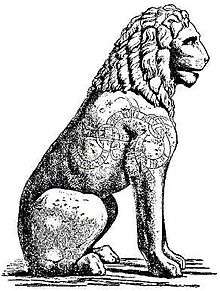
The Vikings raided and settled various parts in the British Isles, in particular the area around the Irish Sea and Scotland, where they became known as the Norse–Gaels. The Uí Ímair dynasty acquired a prominent position among these Scandinavians. These Vikings, mostly Norwegians, came close to completely conquering Ireland until they were defeated by the Irish at the Battle of Clontarf.[68] They would nevertheless remain firmly established in Ireland for generations afterwards, in particular the cities of Dublin, Waterford and Limerick.[68] In the 9th century, Danish Vikings gained control of a part of eastern England, which became known as the Danelaw.[6] England was the part of Europe most heavily subjected to Viking attacks, and it is likely that the Scandinavians would have gained control of all of England if not for the successful resistance of Alfred the Great.[68] In the early 11th century England became part of the North Sea Empire of Danish king Cnut the Great.[68]
Vikings were also active in Francia. Some of these Vikings would sail through the Strait of Gibraltar and pillage the coasts of the Mediterranean Sea. In the early 10th century, a group of Vikings under the leadership of Rollo settled in Rouen, France, and established the Duchy of Normandy. The descendants of these Vikings, known as the Normans, would in the 11th century conquer England, Southern Italy, and North Africa, and play a leading role in launching the Crusades.[6][69] Sub-groups of the Normans include Anglo-Normans, Scoto-Normans, Cambro-Normans, Hiberno-Normans and Italo-Normans.
In the east the Danish Viking were active in raiding the Wends. The most famous colonies created by these Vikings was Jomsborg in modern Pomerania, which became the base of the Jomsvikings.[68]
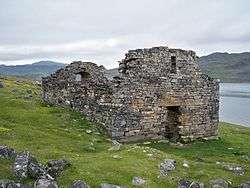
The Swedes were particularly active in Eastern Europe, where they were known as the Rus'.[45][18] They were engaged in extensive trade with the Byzantine Empire and the Abbasid Caliphate, launching raids on Constantinople and expeditions in the Caspian Sea.[68] The Rus' are described in detail by the Arab traveller Ahmad ibn Fadlan, who described them as tall, blond and the most "perfect physical specimens" he had ever seen.[70] In the 9th century, the Viking Rurik is believed to have founded the Rurik dynasty, which eventually developed into Kievan Rus'. By the 11th century, the ruling North Germanic elite of this state, the Rus' people, had converted to Eastern Orthodoxy and were gradually merging with the local East Slavic population, becoming known as the Russians.[18][68] The North Germanic diaspora in the area were thereafter called Varangians.[6] Many of them served in the Varangian Guard, the personal bodyguard of the Byzantine emperors.[45] Among the prominent Scandinavians who served in the Varangian Guard were Norwegian king Harald Hardrada.[18][68]
While the Danes and Swedes were active in Francia and Russia respectively, North Germanic tribes from Norway were actively exploring the North Atlantic.[45] These Vikings were the first sailors in naval history to venture out into the open sea.[71] This initially resulted in the colonization of the Orkney Islands, the Faroese Islands and Iceland.[6] The most important Norse colony was the settlement in Iceland, which became a haven for Scandinavians who sought to preserve their traditional way of life and independence of central authority.[72] The literary heritage of the Icelanders is dispensable for the modern understanding of early North Germanic history and culture.[73] In the late 10th century, the Icelandic explorer Erik the Red discovered Greenland and supervised the Norse settlement of the Iceland.[68] His son Leif later made the first documented trans-oceanic voyage in history and thereafter supervised the attempted Norse colonization of North America.[74]
Later history
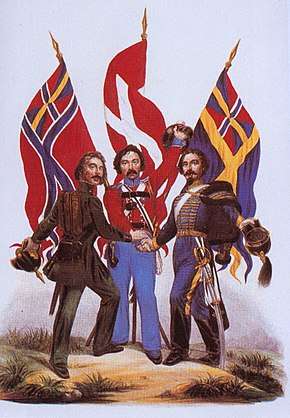
While Vikings were raiding the rest of Europe, their own Scandinavian homeland was undergoing increasing centralization. This is evidenced by the number of larger settlements being built. Some of these settlements became seats for royal mints and bishoprics.[6]
By the mid-11th century, the North Germanic tribes had been converted from paganism to Christianity and were under the rule of centralized states. These states were the kingdoms of Norway, Sweden and Denmark.[6][7] The Scandinavian settlements in Greenland disappeared in the 15th century.[68] Modern North Germanic ethnic groups are the Danes, Faroese people, Icelanders,[53] Norwegians[75] and Swedes.[76][8][9] These ethnic groups are often referred to as Scandinavians.[3][10][77][9][78][79][1][28][31][66][80][81][56][58][82][83][32][84] By historians they are sometimes called Nordic peoples.[85][2] although Icelanders and the Faroese are sometimes excluded from that definition.[10][3] The North Germanic countries, especially Iceland, are along with the nations of East Asia considered some of the most ethnically homogenous countries in the world.[76][86]
In the Late Middle Ages, the countries most associated with North Germanic cultures were briefly united under the Kalmar Union. With the rise of romantic nationalism in the 19th century, many prominent figures throughout Scandinavia became adherents of Scandinavism, which called for the unification of all North Germanic lands.[87] Both during the First Schleswig War and the Second Schleswig War between Denmark and Germany in the 19th century, large numbers of Swedes fought for Denmark to counter a perceived German threat against the North Germanic peoples.[88] In Norway, on the other hand, many prominent public figures disregarded Scandinavism in favour of Pan-Germanism, seeking to create a Pan-Germanic state in unity with Germanic nations in Continental Europe and the British Isles. As Pan-Germanism lost currency after the trauma of World War II, the North Germanic countries and Finland have in the post-war era cooperated through the Nordic Council.[87]
See also
References
- 1 2 3 4 Kennedy, Anthony Garfield (1970). English language reader: introductory essays and exercises. Greenwood Publishing. p. 93.
Then, while the East Germanic tribes (that is, the Goths) passed gradually out of the pages of history and disappeared completely, the North Germanic, or Scandinavian, or Norse, peoples, as they are variously called, became a distinctive people, more and more unlike the West Germanic folk who inhabited Germany itself and, ultimately, Holland and Belgium and England.
- 1 2 Moberg, Vilhelm (1972). History of the Swedish people: from prehistory to the Renaissance. Pantheon. p. 264. ISBN 0394481925.
Ethnically they were of Germanic origin. They spoke a North Germanic tongue, best described as Scandinavian or Old Norse. That is to say, all Vikings spoke the same language, and this must have been conducive to a feeling of solidarity among the Nordic peoples.
- 1 2 3 4 Ostergren, Robert Clifford; Le Boss, Mathias (2011). The Europeans: A Geography of People, Culture, and Environment. Guilford Press. ISBN 1609181409.
The north Germanic peoples occupied the southern part of the Scandinavian Peninsula. They subsequently spread westward across the Danish islands and Jutland, and their linguistic descendants today are the Scandinavians and the Icelanders.
- 1 2 3 4 Gordon & Taylor 1962 "Sweden was the mother of the Scandinavian peoples: from Sweden came both the Danes and the Norwegians. In the early days of Scandinavian expansion Norway was called the noróvegr, just as in later viking times the norðrvegr, just as in later viking times the Baltic lands were the austrvegr. The home of the oldest Norse culture and the oldest Norse traditions was Sweden, though these traditions had to be carried to distant Iceland before they were given an enduring form. Snorri made no mistake when he began his history of the northern nations, Heimskringla, with the legends of ancient Sweden."
- 1 2 3 D'Epiro, Peter (2010). The Book of Firsts: 150 World-Changing People and Events, from Caesar Augustus to the Internet. Knopf Doubleday Publishing Group. ISBN 0307476669.
The Northmen, Norsemen, or Norse were North Germanic peoples who settled in the Scandinavian countries of Noway, Sweden, and Denmark
- 1 2 3 4 5 6 7 8 Waldman & Mason 2006, pp. 831–835
- 1 2 Bruce, Alexander M. (2014). Scyld and Scef: Expanding the Analogues. Routledge. p. 16. ISBN 1317944216.
These Langobards thus lived south of the Angles and east of the Saxons, and were somewhat removed from the North Germanic people of Denmark, Sweden, and Norway
- 1 2 3 Spaeth, John Duncan Ernst (1921). Old English Poetry. Princeton University Press. p. 190.
The word Nordic is used to suggest the racial origin of the peoples of Northern and Northwestern Europe. The word Germanic denotes their linguistic and cultural unity. The main divisions of Germanic are: 1. East Germanic, including the Goths, both Ostrogoths and Visigoths. 2. North Germanic, including the Scandinavians, Danes, Icelanders, Swedes, "Norsemen." 3. West Germanic. The Old English (Anglo-Saxons) belong to this division, of which the continental representatives are the Teutonic peoples, High and Low Franks and Saxons, Alemanni, etc. English and German are both West Germanic languages. Care should be taken not to confuse Germanic and German. Germcm (Deutsch) is the literary language of the High German division of the Teutonic dialects. "Germanic" (Germanisch) is a generic term covering all that is included in East, North and West Germanic.
- 1 2 3 Thompson, Stith (1995). Our Heritage of World Literature. Cordon Company. p. 494. ISBN 0809310910.
The North Germanic, or Scandinavian group, consists of the Norwegians, Danes, Swedes, and Icelanders. It is particularly interesting to follow the literary activity of three of these Germanic peoples, the Anglo-Saxons, the Scandinavians, and the Germans.
- 1 2 3 4 Waldman & Mason 2006, p. 830 "The Vikings, known by a number of different names, the most prevalent alternate name Norse or Norsemen, were related to GERMANICS, that is, other Germanic-speaking peoples. Grouped together as SCANDINAVIANS they are also described as Danes, Swedes, and Norwegians, depending on the part of Scandinavia in which they originated..."
- 1 2 Kristinsson, Axel (2010). Expansions: Competition and Conquest in Europe Since the Bronze Age. ReykjavíkurAkademían. p. 176. ISBN 9979992212.
The same can be said of Viking Age Scandinavians who did not have a common ethnonym but expressed their common identity through the geographical and linguistic terms...
- ↑ "Primary History, Vikings: Who were the Vikings". BBC. Retrieved 19 January 2017.
The name 'Viking' comes from a language called 'Old Norse' and means 'a pirate raid'. People who went off raiding in ships were said to be 'going Viking'.
- ↑ Adam of Bremen 2.29.
- 1 2 Richards, Julian D. (8 September 2005). Vikings : A Very Short Introduction. UK: Oxford University Press. pp. 15–16. ISBN 9780191517396. Retrieved 7 February 2018.
- ↑ Michael Lerche Nielsen, Review of Rune Palm, Vikingarnas språk, 750–1100, Historisk Tidskrift 126.3 (2006) 584–86 (pdf pp. 10–11) (in Swedish)
- ↑ Louis John Paetow, A Guide to the Study of Medieval History for Students, Teachers, and Libraries, Berkeley: University of California, 1917, OCLC 185267056, p. 150, citing Léopold Delisle, Littérature latine et histoire du moyen âge, Paris: Leroux, 1890, OCLC 490034651, p. 17.
- ↑ Baldour, John Alexander; Mackenzie, William Mackay (1910). The Book of Arran. Arran society of Glasgow. p. 11.
- 1 2 3 4 5 Waldman & Mason 2006, pp. 666–675
- 1 2 3 "History of Europe: Barbarian migrations and invasions The Germans and Huns". Encyclopædia Britannica Online. Retrieved July 13, 2018.
- 1 2 3 4 5 6 7 8 Waldman & Mason 2006, pp. 830–831
- 1 2 3 "History of Europe: The Bronze Age". Encyclopædia Britannica Online. Retrieved July 13, 2018.
- 1 2 Waldman & Mason 2006, p. 786
- ↑ "Ancient Rome: The Barbarian Invasions". Encyclopædia Britannica Online. Retrieved July 13, 2018.
- 1 2 3 Gordon & Taylor 1962 "From the beginning of history energetic warlike tribes issued from Sweden and passed to a career of conquest in the south; in the phrase of the Gothic historian Jordanes, Sweden was a 'factory of nations' (officina gentium). The migrations of the Burgundians, Goths, and Gepids (preceded perhaps by the Vandals) are the earliest that are known; archaeology dates the coming of the Burgundians to the south shore of the Baltic about 200 B.C.," and the Goths may have begun their southward movement about the same time..."
- ↑ Waldman & Mason 2006, pp. 665–666
- ↑ Amory, Patrick (2003). People and Identity in Ostrogothic Italy, 489-554. Cambridge University Press. p. 141. ISBN 0521526353.
For they all have white bodies and fair hair, and are tall and handsome to look upon, and they use the same laws and practise a common religion. For they are all of the Arian faith, and have one language called Gothic; and, as it seems to me, they all came originally from one tribe, and were distinguished later by the names of those who led each group.
- ↑ Jordanes 551, p. IV "Now from this island of Scandza, as from a hive of races or a womb of nations, the Goths are said to have come forth long ago under their king, Berig by name."
- 1 2 3 Gordon & Taylor 1962 "The later expansion of the Scandinavian nations in the viking age may be regarded as the final wave of North Germanic migration; but the process was probably not the same, and the results were essentially different. When the Goths and Burgundians migrated from Scandinavia, the North Germanic peoples spoke a language nearly identical with that of other Germanic nations. After their departure came a period of great linguistic change, when Germanic broke up into distinct groups of dialects; the language of the Goths then became rapidly differentiated from Norse, and their national traditions and culture also took divergent lines of development."
- ↑ Paul the Deacon 1974, pp. 2–3 "The race of Winnili, that is, of Langobards, which afterwards ruled prosperously in Italy, deducing its origin from the German peoples, came from the island which is called Scadinavia, although other causes of their emigration are also alleged."
- ↑ Paul the Deacon 1974, p. 1
- 1 2 3 Gordon & Taylor 1962, p. 265 "Norse was the language spoken by the North Germanic peoples (Scandinavians) from the time when Norse first became differentiated from the speech of the other Germanic peoples, that is, roughly, from about 1oo, until about 1500."
- 1 2 Barbour, Stephen; Stevenson, Patrick (1990). Variation in German: A Critical Approach to German Sociolinguistics. Cambridge University Press. p. 29-30. ISBN 0521357047.
For the period when the existence of the Germanic tribes is first clearly recorded by Roman writers, archaeological evidence suggests five tribal groups, with perhaps five incipient distinct Germanic languages, as follows: (1) North Germanic tribes (Scandinavians)...
- 1 2 Gordon & Taylor 1962 "Somewhat later was the migration of the Heruli, who were driven out by the southward advance of the Danes in Sweden. After centuries of wandering, The Heruli were overwhelmed by the Lombards, and the remnant of them returned to their old home in south Sweden, about a.d. 510. "
- ↑ Waldman & Mason 2006, pp. 388–390
- ↑ Johnston, Ruth A. (2005). A Companion to Beowulf. Greenwood Publishing Group. p. 1. ISBN 031333224X.
THE NORTH GERMANIC TRIBES
- ↑ "Germanic law". Encyclopædia Britannica Online. Retrieved July 13, 2018.
- 1 2 3 4 Waldman & Mason 2006, pp. 835–841
- ↑ "Germanic religion and mythology". Encyclopædia Britannica Online. Retrieved July 13, 2018.
- ↑ Merriam-Webster, Inc (1995). Merriam-Webster's Encyclopedia of Literature. p. 1111. ISBN 0877790426.
His [Thor's] figure was generally secondary to that of Odin, who in some traditions was his father; but in Iceland, and perhaps among all North Germanic peoples except the royal families, he was apparently worshiped more than any other god
- ↑ Bury, John Bagnell (1964). The Cambridge Medieval History, Volume 2. The University Press. p. 428.
During the second or third century A.D. the Sarmatian hordes were driven out by the German Goths and Heruli. The Gothic dominion lasted over two centuries, and is the only non- nomadic episode in the history of the steppe. The Goths were the most magnificent German people, and their influence on the Slavs must have been enormous.
- 1 2 Jordanes 551, p. III
- ↑ Temple, Sir William (1757). "The Works of Sir William Temple Bart,: Complete in Four Volumes Octavo. : To which is Prefixed, The Life and Character of the Author, Volume 3". Retrieved July 16, 2018.
- ↑ Gordon & Taylor 1962 "There is evidence of early viking activity among the Scandinavian peoples, as among the other seafaring Germans: it is known from Frankish annals and the AngloSaxon poem Beowulf, for example, that between 512 and 520 Hugleik, King of the Gautar in the south of Sweden, made a raid on the Rhineland, where he took great booty, but was defeated and killed before he could carry it off. And Norwegian vikings had made settlements in the Shetlands before 700."
- 1 2 Gordon & Taylor 1962 "The destruction by Charlemagne of the naval power of the Frisians, once the rivals of the Norsemen on the sea, coincided with the rise of Scandinavian power, and probably played an important part in facilitating the Scandinavian advance."
- 1 2 3 4 5 "Viking". Encyclopædia Britannica Online. Retrieved July 13, 2018.
- ↑ McLaughlin, John Cameron (1970). Aspects of the history of English. Holt, Rinehart and Winston. p. 35.
Some of the Vikings were Swedes, some Norwegian, and some Danes, but they were all North Germanic people who spoke much the same language and whose social and cultural patterns of behavior were very much alike
- ↑ Baldi, Philip (1995). An Introduction to the Indo-European Languages. Southern Illinois University Press. p. 128. ISBN 0809310910.
The North Germanic peoples were quite expansive from the time of the Vikings (from about 800 Ad.
- 1 2 Fee, Christopher R. (2011). Mythology in the Middle Ages: Heroic Tales of Monsters, Magic, and Might: Heroic Tales of Monsters, Magic, and Might. ABC-CLIO. p. 3. ISBN 0313027250.
“Viking” is a term used to describe a certain class of marauding Scandinavian warrior from the 8th through the 11th century. However, when discussing the entire culture of the northern Germanic peoples of the early Middle Ages, and especially in terms of the languages and literatures of these peoples, it would be more accurate to use the term “Norse.” Therefore during the Middle Ages and beyond, it therefore might be useful to speak of “German” peoples in middle Europe and of “Norse” peoples in Scandinavia and the North Atlantic.
- 1 2 3 Fortson, Benjamin W. (2009). Indo-European Language and Culture: An Introduction. John Wiley & Sons. p. 372. ISBN 1405188960.
The northern Germanic pirates known as Vikings mostly spoke varieties of Old Norse; for reasons that are still unclear, in the late eighth century these Norsemen began a series of raids that soon grew into a scourge as they ravaged and terrified any part of Europe that was reachable by boat.
- ↑ Tolkien, John Ronald Reuel; Drout, Michael D. C. (2002). Beowulf and the critics. Arizona Center for Medieval and Renaissance Studies. p. 156. ISBN 0866982906.
Vikings (who were Northern Germanic tribes, i.e., "Teutons" in the old nomenclature)...
- ↑ Davies, Norman (1999). The Isles : A History: A History. Oxford University Press. p. 229-230. ISBN 0716600994.
For reasons of convenience, modern scholarship calls both sorts of Scandinavians 'Vikings', therby blurring the distinction. Furthermore, there is another mistaken tendency to identify the 'Northmen' or 'Norsemen' with modern Norway, and the 'Danes' with modern Denmark. This is not appropriate for the simple reason that in the period in question the separate Scandinavian nations of Norwegians, Danes, and Swedes had not yet come into existence. The Viking appellation, therefore, needs to be glossed. It refers to an activity, not to an ethnic group.
- ↑ Webster, Hutton (1933). Early European Civilization. D. C. Heath and Company. p. 380.
North Germanic peoples, or the Northmen as we can more fitly describe them
- 1 2 Herbermann, Charles George (1913). The Catholic encyclopedia: an international work of reference on the constitution, doctrine, discipline, and history of the Catholic church, Volume 7. Universal Knowledge Foundation. p. 615.
[Icelanders] dwell chiefly by the shores of the ocean, and in the river valleys which open towards the sea. They belong for the greater part to the North Germanic race (Norsemen)
- ↑ Smith, Jeremy J. (2006). Essentials of Early English: Old, Middle and Early Modern English. Routledge. p. 8. ISBN 1134292430.
Towards the end of the Anglo-Saxon period, large numbers of North Germanic (Norse) peoples settled in northern England.
- ↑ Leeming, David A. (2014). The Handy Mythology Answer Book. Visible Ink Press. p. 143. ISBN 1578595215.
Who were the Norse people? The term Norse is commonly applied to pre-Christian northern Germanic peoples living in Scandinavia during the so-called Viking Age. Old Norse gradually developed into the North Germanic languages, including Icelandic, Danish, Norwegian, and Swedish. Bronze Age rock carvings in Scandinavia suggest a Bronze Age origin for the Norse people.
- 1 2 Daily, Kathleen N. (1976). Norse Mythology A to Z. Infobase Publishing. p. VII. ISBN 1438128010.
The Norse (people of the north) are known today as the Scandinavians— the people of Norway, Sweden, Denmark, Iceland, and the Faroe Islands
- ↑ The World Book encyclopedia, Volume 2. World Book Inc. 1999. p. 378. ISBN 0716600994.
Europeans called the Scandinavians Norsemen, Northmen, or Danes
- 1 2 Davies, Norman (1999). The Isles : A History: A History. Oxford University Press. p. 229-230. ISBN 0716600994.
Sometime in the late ninth century, a Norse merchant living in England visited King Alfred and presented him with a detailed account of his homeland. The merchant's name was Ottar... Ottar belonged to a group of peoples who were beginning to have a huge impact on European history. They are now called 'Scandinavians', though historically they were called 'Northmen'.
- ↑ McTurk, Rory (2008). A Companion to Old Norse-Icelandic Literature and Culture. John Wiley & Sons. p. 7. ISBN 140513738X.
The term 'Norse' is often used as a translation of norroenn. As such it applies to all the Germanic peoples of Scandinavia and their colonies in the British Isles and the North Atlantic.
- ↑ Luscombe, David; Riley-Smith, Jonathan (2004). The New Cambridge Medieval History: Volume 4, C.1024-c.1198. Cambridge University Press. p. 290. ISBN 0521414113.
Contemporaries distinguished four main groups of Scandinavians: Danes, Götar, Svear and Norwegians or Northmen (a name that foreigners sometimes used to describe all Scandinavians
- ↑ DeAngelo, Jeremy (2010). "The North and the Depiction of the "Finnar" in the Icelandic Sagas". Scandinavian Studies. 82 (3): 257–286. Retrieved 30 September 2018.
The term "Norse" will be used as a catchall term for all North Germanic peoples in the sagas who are placed in opposition to the Finnar by the authors
- ↑ Gordon & Taylor 1962 "Parts of Scandinavia must have been over-populated, to judge from the never-ending stream of men that came forth from those lands; in viking life mortality was high, but there was never any lack of men to replace those killed. The hypothesis of over-population is strengthened by such legends as that told in selection xxi, according to which the island of Gotland became crowded, and one man of every three was selected by lot and sent away from the island ; and Saxo Grammaticus has a similar story of the origin of the Danish settlements on Baltic lands in the tenth century. Over-population, moreover, is the explanation of viking activity given by the early Norman his- torians, Dudo and William of Jumieges."
- ↑ Gordon & Taylor 1962 "An immediate cause of many of the early raids was the fear and resentment roused in the Scandinavians by Charlemagne's military operations in the north of Germany, especially as he threatened to invade Denmark."
- ↑ Gordon & Taylor 1962 "Great political changes, too, in the ninth century drove many Norsemen into exile, who then took up a viking career. Harald Fairhair exiled many great fighting men in the process of consolidating the realm of Norway; and the struggles of rival princes for the throne of Denmark drove bands of followers abroad, as one or other of the claimants got the upper hand."
- ↑ Gordon & Taylor 1962 "The true Scandinavian expansion, when distinctively Norse traditions and speech were carried to other lands, belongs to the viking period, which may be roughly dated from 750 to 1050. During this period bands of Scandinavian adventurers , sometimes in forces large enough to be called armies, sailed overseas in search of plunder, or to win land for settlement; these piratical adventurers were called vikings."
- 1 2 Diringer, David (1948). The Alphabet: A Key to the History of Mankind. Philosophical Library. p. 518.
"Old Norse" was spoken by the North Germanic or Scandinavian peoples
- ↑ Katzner, Kenneth; Miller, Kirk (2002). The Languages of the World. Routledge. p. 12. ISBN 1134532881.
The North Germanic tribes spoke a language we now call Old Norse, the ancestor of the modern Scandinavian languages
- 1 2 3 4 5 6 7 8 9 10 Gordon & Taylor 1962
- ↑ Waldman & Mason 2006, pp. 559–567
- ↑ Jones 2001, p. 164 "I have seen the Rus as they came on their merchant journeys and encamped by the Atil (Itil, Volga). I have never seen more perfect physical specimens, tall as date palms, blond and ruddy..."
- ↑ Gordon & Taylor 1962 "The final stage of Norse expansion in the west, the colonization of Greenland (which led to the discovery of America) was accomplished by notable feats of seamanship. These feats, moreover, afford striking illustration of the Norsemen’s great contribution to navigation: they were the first people who ventured to sail out to open sea. Before viking seafarers appear in history, voyagers were careful to follow courses that were never far from land; but the Norsemen struck boldly across the North Sea to the Orkneys and Shetlands, and they voyaged regularly across the open Atlantic to Iceland. These voyages were made in open boats; some ships had a small cabin at either end, but many had no deck or shelter of any kind. The hardships of voyages across the open sea in such ships must have been intense, but the Norsemen endured them habitually."
- ↑ Gordon & Taylor 1962 "The first settler in Iceland was the Norwegian Ingolf, who came in 874. 1 He was soon followed by many of the exiled chiefs whom Harald had driven from Norway and the Scottish isles-; they were indeed the larger part of the settlement. They were men who were determined to keep their old freedom at all costs, and preferred to give up their possessions and live in a wild and barren land rather than yield to the new monarchy. They came to Iceland to save the old order of heroic society, and they pre- served it there much as it had existed in early Germanic times before the great kings made their power absolute by destroying the free fellowship of the small lord and his men. The settlers of Iceland were men of more than usual force of will and love of liberty, the best of the Norwegian aristocracy The propor- tion of well-born men there was greater than in any other Scandinavian land, and it was in the gentleman’s household that the literary arts were practised most. Half or more than half of the literary power of Norway was thus concentrated in Iceland, and it throve the more for its concentration."
- ↑ Gordon & Taylor 1962 "In the eyes of the literary historian the most important of the Norse colonies is Iceland ; for in Iceland was written the greater part of Old Norse literature that survives today, and almost all that is of merit."
- ↑ Gordon & Taylor 1962 "The Greenland settlers and their descendants were intrepid voyagers and explorers. Eirlk’s son Leif sailed across the Atlan- tic to Scotland on his way to Norway, making the first trans- oceanic voyage known in history. And the Greenlanders also reached America ; no one who is acquainted with the historical value of Norse tradition can doubt it."
- ↑ Berlitz (1 June 2015). Berlitz: Norway Pocket Guide. Apa Publications (UK). ISBN 1780048599.
Some 86 percent of the people living in Norway today are ethnic Norwegians, a North Germanic people
- 1 2 Höffe, Otfried (2007). Democracy in an Age of Globalisation. Springer Science & Business Media. p. 124. ISBN 1402056621.
Similarly homogenous are the countries of China (with 92% Han Chinese) and Korea, as well as Scandinavia, in particular Sweden (where more than 95% belong to the North Germanic people of the Swedes. Iceland, which is even more homogeneous, was settled by the Vikings almost a thousand years ago, has remained unspoilt by outsiders ever since, and is now comprised almost exclusively of Icelanders in the ethnic sense.)
- ↑ Iowa Council of Teachers of English (1967). Iowa English Yearbook, Issue 1-6. p. 3.
The Scandinavians are a North Germanic people closely related to the Anglo-Saxons, the Frisians, the Germans, and the Dutch.
- ↑ Leach, Henry Goddard (1939). The American-Scandinavian Review. American-Scandinavian Foundation. p. 180.
One of the reasons for this is doubtless to be found in the close racial affinity of the Scandinavians, as North Germanics, with the Anglo-Saxons, and in the consciousness of this affinity existing in all modern nationality groups of North Germanic ethnic stock
- ↑ Donaldson, Bruce C. (1983). Dutch: a linguistic history of Holland and Belgium. M. Nijhoff. p. 122. ISBN 9024791669.
Not all the Germanic peoples left the Baltic region in the period concerned and consequently those that stayed behind were to become the ancestors of the present-day North Germanic peoples, the Scandinavians
- ↑ Bolling, George Melville; Bloch, Bernard (1968). Language. Linguistic Society of America. p. 29.
Northern Germanic peoples, i.e. the Scandinavians...
- ↑ Ränk, Gustav (1976). Old Estonia, the people and culture. Indiana University. p. 8.
Contacts are not impossible also with the Northern Germanic peoples, i.e., with the Scandinavians directly across the sea
- ↑ Sawyer, Peter (2001). The Oxford Illustrated History of the Vikings. Oxford University Press. p. 2. ISBN 0192854348.
The peoples these Scandinavians encountered game them a variety of names; the Franks normally called them Northmen or Danes, while for the English they were generally Danes or heathens.
- ↑ Jones 2001, p. 485 "North Germanic (Scandinavian) peoples"
- ↑ Jones 2001, p. 71 "Throughout the Viking period the Nordic peoples continued to speak a mutually intelligible language."
- ↑ Gall, Timothy L.; Hobby, Jeneen (2009). Worldmark Encyclopedia of Cultures and Daily Life: Europe. Gale. p. 147. ISBN 1414464304.
Descended from northern Germanic tribes, the Danes are among the most ethnically homogeneous people in Europe
- 1 2 Meland, Astrid (May 7, 2009). "Slik ble vi germanersvermere" (in Norwegian). Dagbladet. Retrieved July 13, 2018.
- ↑ Chapman and Hall (1916). The Fortnightly Review, Volume 105. Chapman and Hall. p. 244.
In 1848-9 Sweden sent troops to Funen with the intention of fighting Germany, and in 1864 Swedes streamed into Denmark in order to prevent the danger threatening the North Germanic peoples.
Bibliography
- Gordon, Eric Valentine; Taylor, A. R. (1962). An Introduction to Old Norse. Clarendon Press.
- Jones, Gwyn (2001). A History of the Vikings. Oxford University Press. ISBN 0192801341.
- Jordanes (551). THE ORIGIN AND DEEDS OF THE GOTHS. Translated by Mierow, Charles C.
- Paul the Deacon (1974). History of the Lombards. ISBN 0812210794.
- Waldman, Carl; Mason, Catherine (2006). Encyclopedia of European Peoples. Infobase Publishing. ISBN 1438129181.